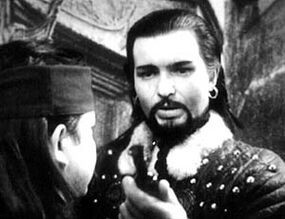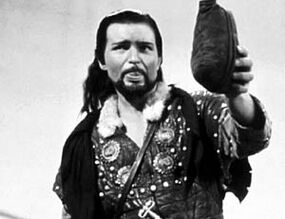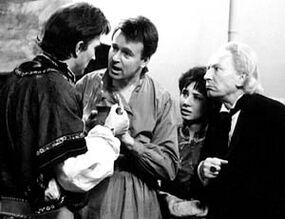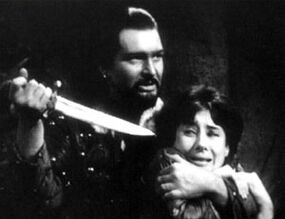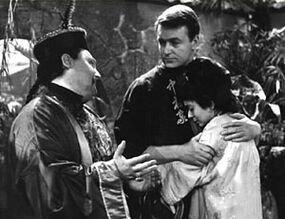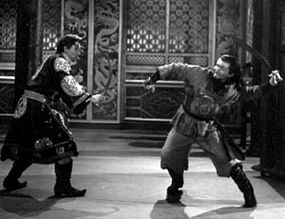Marco Polo (TV story)
- You may wish to consult
Marco Polo (disambiguation)for other, similarly-named pages.
Marco Polo was the fourth serial of season 1 of Doctor Who.
This was the first occasion in which a famous person from history appeared on the series. It also saw the TARDIS act as a plot piece rather than something the travellers must return to once they have finished their adventuring.
Marco Polo did a much better job of recreating historical societies than other serials. It showed a mixed-ethnic group rather than a stereotypical collection of one race. Reference is made to real-world narcotics when Ping-Cho relates a fairytale that features hashish. Such references don't reappear until The Talons of Weng-Chiang.
Almost uniquely for the 1963 series, this story has a narrator. Mark Eden reads aloud while the map of the travellers' journey is shown. As of 2021, there have been few if not any televised stories that feature a character providing linking narration between sequences, with the debatable exceptions of Rassilon in 2010's The End of Time, Clara Oswald in 2013's The Name of the Doctor and Tasha Lem in The Time of the Doctor.
Marco Polo is perhaps most notable as the earliest and longest Doctor Who story which is completely missing. Its first episode, "The Roof of the World", is the earliest-broadcast episode to be missing. As of 2021, no episodes exist in the BBC archive.
Synopsis
Arriving in Central Asia in 1289, the Doctor and his companions join the caravan of the famous Venetian explorer Marco Polo as it makes its way from the snowy heights of the Pamir Plateau, across the treacherous Gobi Desert and through the heart of imperial Cathay.
Having witnessed many incredible sights and survived a variety of dangers, they arrive at the mighty Kublai Khan's Summer Palace in Shang-tu, where the Doctor strikes up an extraordinary friendship with the now-aged ruler.
They move on at last to the even more sumptuous Imperial Palace in Peking, where the travellers save the Khan from an assassination attempt by the Mongol warlord Tegana — supposedly on a peace mission — before departing once more in the TARDIS.
Plot
The Roof of the World (1)
- Not to be confused with the Big Finish adventure of the same name.
The TARDIS crew have arrived in the snowy wastes of the Plain of Pamir. The ship is damaged and unable to provide light, heat or water. The First Doctor, Ian, Barbara and Susan face the prospect of freezing to death as night approaches and the temperature plummets.
Ian and Barbara go out onto the tundra to look for fuel, but Barbara sees a figure in the snow and they hurry back. Meanwhile, the Doctor has discovered what is wrong with the TARDIS but is interrupted by Ian and Barbara's return. The creature follows them back and appears at the TARDIS door. The foursome chase after it but are soon surrounded by Mongol soldiers on the verge of killing them for being evil spirits. A Western man, who turns out to be Marco Polo, interrupts them.
Polo welcomes the Doctor, who is suffering from altitude sickness, and his companions to his company. He introduces some of his fellow travellers, including Tegana, a Mongol warlord. Tegana is a peace emissary from the Khan Noghai, who has been at war with Kublai Khan. A young Chinese woman named Ping-Cho is also travelling with Polo so she may meet her seventy-five-year-old groom in her arranged marriage. Ping-Cho forms a strong friendship with Susan.
The Mongols fear the Doctor is an evil sorcerer who is powerless outside the TARDIS, so Marco Polo forbids him from entering it until their party has stopped in a town at the edge of the desert. Here, Polo says, the Doctor may fix his vessel.
When the caravan stops at the way station in Lop, Marco Polo tells the Doctor he is requisitioning his "flying caravan" as a prize for the Emperor to attempt to buy his way out of his service.
Meanwhile, the lord Tegana is given a poison for the caravan's water supply by a man. Tegana tells the man he shall use it on the caravan's water supply when they cross the Gobi desert. He then tells the man to follow them out, and on the third night, he shall walk back to him and they will ride back to Lop, wait for two days and go back to the caravan. He then says they shall take the "thing of magic" that will bring Kublai Khan to his knees.
The Singing Sands (2)
The travellers make their way across the Gobi Desert. The Doctor, in a show of petulance, refuses to come out of his tent when they settle for the night, distressing Susan. One night when Ian and Marco Polo are playing chess, Susan vents her frustration that they are stuck on Earth rather than exploring the stars. This spirit for exploring provokes Ping-Cho and Susan to follow Tegana as he walks off into the night. A vicious sandstorm, during which Ping-Cho and Susan are briefly lost, prevents Tegana from poisoning the gourds. Instead, he slices them open in the night, knowing full well that bandits will get the blame.
Marco Polo insists the caravan press on to the next stop, but the water rations grow lower as the days pass. Finally, Tegana is dispatched to find a fabled oasis.
The Mongol finds the oasis easily and drinks from it. "Here's water, Marco Polo", he cries, letting his cup of water pour onto the sand. "Come for it!"
Five Hundred Eyes (3)
With the water supply completely exhausted, the situation grows desperate. The travellers only survive the arid conditions when the Doctor and Susan collect water which condensed on the TARDIS walls in the night.
The caravan moves on to the next way-station at Tun-Huang, where stocks are replenished and they meet an incredulous Tegana, who rejoins their caravan. Ping-Cho makes their stay pleasant with the tale of Ala-eddin (Aladdin) and the Hashashin (or assassins).
Tegana slips away during the performance and makes his way to the Cave of Five Hundred Eyes, where he is told by the Mongol agents Malik and Acomat that Noghai is assembling an army and marching toward Karakorum. Tegana tells Acomat, a bandit, to attack the caravan soon and kill Marco Polo and the others. Their plans, however, have been partially overheard by Barbara, who followed Tegana to the cave, though she does not realise the extent of Tegana's involvement. She is discovered and held prisoner by Acomat and Malik while Tegana returns to the caravan, feigning surprise when her disappearance is discovered.
The Doctor deduces that Barbara may be at the cave, gets the direction from a man named Chenchu and heads there, accompanied by Susan and Ping-Cho.
The Doctor, Susan and Ping-Cho find the cave and enter. Ping-Cho finds Barbara's handkerchief and they all start to shout for Barbara.
In the secret room, a Mongol holds a knife to Barbara's throat.
Suddenly, Susan cries out, pointing to the wall where there is a pair of "painted" eyes moving.
The Wall of Lies (4)
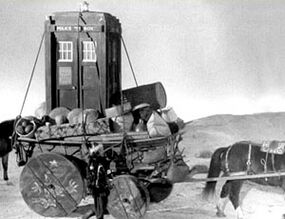
Marco, Ian and Tegana arrive at the cave after being tipped off by Chenchu. Barbara is rescued after Ian discovers the secret room.
When the party returns to the caravan, Tegana tries another tactic. He tries to make Marco suspicious by telling him that Susan has an unhealthy hold over Ping-Cho and the Doctor has a second key to the TARDIS. This is countered when Barbara states that she was only in danger as she followed Tegana to the cave, but Tegana flatly denies ever having been there before. Marco stamps his authority on the caravan by separating Ping-Cho and Susan, making them even more suspicious of Tegana. At the next way-station, Tegana's plans are bolstered when he proves to Marco that the Doctor has a second key to the TARDIS by getting Polo to witness the Doctor leaving the ship. Polo seizes the key and tries to go in, but the Doctor warns him that the ship will be destroyed if an unauthorised person enters it. He is taken away and held under guard.
The caravan now catches sight of the Great Wall of Cathay. The route turns south to Lan-Chow along the banks of the Yellow River. At the next town, Sinju, Tegana meets with Acomat and tells him to attack the caravan two nights later as they journey through the bamboo forest. Everyone is to be killed. Acomat goes to wait in the jungle for Tegana's signal to attack.
To escape from Polo, Ian cuts through the tent and avoids the guard. His plan is to knock the guard out and allow the others to escape; however, when he reaches the front of the tent, he discovers the guard is already dead.
Rider from Shang-Tu (5)
Unwilling to leave Polo and his party to their fate, Ian alerts them to the oncoming danger. He wakes Polo, who wakes Tegana, and they begin to arm themselves. Ian decides it would be best to frighten off the attacking bandits by throwing bamboo into the fire to explode noisily. When the bandits attack, Acomat is slain by Tegana as he is on the point of exposing him. The other bandits flee in fear. In thanks for their help defeating the bandit attack, Marco Polo allows Susan and Ping-Cho to share company once more and permits the others to walk freely again.
The Doctor and his companions have worked out that Tegana is the source of many of the journey's troubles, but cannot make Marco Polo realise how dangerous he is. A new traveller arrives at the caravan, a message rider named Ling-Tau. He has travelled from Shang-Tu, which is three hundred miles away in just twenty-four hours, changing horses every three miles. He bears a message commanding the caravan to speed up, so Marco orders that once they reach the city of Cheng-Ting, the travellers shall all take to horseback while the TARDIS and the other belongings are brought on later. As ever, Tegana has another plot at the next way station. He meets an ally called Kuiju and bribes him to try to steal the TARDIS while the convoy is split up and take it to Karakorum, where Noghai's troops are massing.
Ping-Cho knows where Marco has hidden the two keys to the TARDIS and gives one to Susan to help the time travellers escape. Later that night, the Doctor and his companions sneak out to return to the TARDIS and escape, but Susan returns to say goodbye to Ping-Cho. As she returns, she begins to enter the TARDIS, but she is grabbed by Tegana. She screams.
Mighty Kublai Khan (6)
Ian leaves the TARDIS to convince Tegana to free Susan. Tegana orders the others out of the TARDIS and frees Susan only when the Doctor returns the TARDIS key to Polo. Ian takes the blame on himself for stealing the TARDIS key to save Ping-Cho. As the journey enters its final phases, Ian tries to ingratiate himself with Marco Polo again by telling him the truth about the TARDIS. Marco does not believe that the TARDIS can move through time and says he knows Ian to be a liar as he has deduced that Ian did not steal the key and it was Ping-Cho after all. Ping-Cho hears this and, fearing detection, she flees the caravan.
On finding her missing, Tegana and Ian offer to go looking for her. Polo says that Ian should go as when they meet Kublai Khan, Tegana should be there. Ian finds her back at Cheng-Ting, having ridden there alone, which is just as well; while there he uncovers the fact that Kuiju has stolen the TARDIS from the second convoy. Back with Polo, Susan and Barbara confront Polo. They believe Ping-Cho should not marry a man so much her senior. This provokes Polo to send Tegana after Ian to ensure he is not trying to liberate Ping-Cho and make off with the TARDIS.
Eventually, Polo's party arrives at Kublai Khan's palace. The Doctor initially shows belligerence towards Khan but they soon bond over their great ages and the maladies that ensue. Before Khan and the Doctor go off together, Khan tells Polo that soldiers are swelling around their borders, so that it would appear that Tegana's information has been incorrect; Khan awaits the great warrior's return.
When Ian and Ping-Cho find the bandit Kuiju on the road to Karakorum, they force him to admit the truth, but Tegana arrives and brandishes his sword. Ian threatens to kill Kuiju, but Tegana says he is of no importance. Tegana approaches, slicing the air with his sword. He smiles sadistically.
Assassin at Peking (7)
The stand-off between Ian and Tegana is broken when Ling-Tau and a band of soldiers arrive. They kill Kuiju, but yet again Tegana talks his way out of a tight situation. The entire party agrees to ride on to the imperial palace in Peking. During the stand-off, expecting Ian and Ping-Cho to be killed, Tegana pledges his allegiance to Noghai.
Meanwhile, at the capital city, the Khan engages the Doctor in a game of backgammon. The Doctor wins thirty-five elephants, four thousand white stallions, twenty-five tigers, the sacred tooth of the Buddha and the entire commerce of Burma for a year — but wagers all this on the liberation of his TARDIS and loses. The Khan presses Marco for the history of the "magic caravan". The emissary admits he was wrong to try to obtain the vehicle, but he only did it to buy his freedom. The Khan is not impressed. He warns Marco that if he does not regain his trust, he will be banished from court.
When Tegana returns to court, he convinces Khan that Polo has been defying the laws of the land by not confiscating the TARDIS and slaying the Doctor and his companions when they tried to steal it back. Ian and Ping-Cho tell Khan that Tegana stated he is working for Noghai. Khan is not sure whether to believe them. He says it must be judged in a matter of the court.
Nevertheless, events take a turn for the better for others. Ping-Cho is spared a loveless marriage when she learns the elderly man she was to marry has passed away after drinking an elixir of life. Offered the chance to return to Samarkand, she instead chooses to remain with the Khan's court in Peking.
The Doctor and his companions, now imprisoned, decide someone has to stop Tegana. They believe he is going to kill Khan to create an easy victory for Noghai's army. They attack their guard and break free. They meet Polo and tell him of their theory. Polo immediately runs to the throne room.
Tegana has slain Khan's guards, as well as the Grand Vizier when he tried to protect the Khan and is moving in for the kill when the Doctor and his allies arrive. Tegana is stopped by a lengthy sword fight with Polo. His mission failed, Tegana takes his own life with a spear rather than be killed by Khan's men. As the bodies are removed, Marco Polo hurriedly gives the Doctor and his party the key to the TARDIS and bids them escape. The "magic caravan" fades away before the eyes of the Khan and his courtiers. The Khan forgives Marco Polo and implies that he will be permitted to return to Venice. As Polo wonders where the Doctor and his companions are now, an image of the time travellers standing around the TARDIS console is shown superimposed against a starscape.
Cast
- Dr. Who - William Hartnell
- Ian Chesterton - William Russell
- Barbara Wright - Jacqueline Hill
- Susan Foreman - Carole Ann Ford
- Marco Polo - Mark Eden
- Tegana - Derren Nesbitt
- Ping-Cho - Zienia Merton
- Kublai Khan - Martin Miller
- Chenchu - Jimmy Gardner
- Man at Lop - Leslie Bates
- Mongol Bandit - Michael Guest
- Malik - Charles Wade
- Acomat - Philip Voss
- Ling-Tau - Paul Carson
- Wang-Lo - Gabor Baraker
- Kuiju - Tutte Lemkow
- Empress - Claire Davenport
- Vizier - Peter Lawrence
- Office Foreman - Basil Tang
- Yeng - O. Ikeda
Uncredited cast
- Mongolian Warrriors - John Lee, Roy Vincente, Ronald Chee, Carlton Ngui, Clem Choy, Bill Brandon, Arnold Lee
- Atttendant on Ping-Cho - Zohra Sehgal
- Double for Marco Polo’s Hand - John Woodcock
- Chinese Lady of quality - Violet Leon
- Chinese Woman Attendant - Suk Hee S'Hng
- Chinese Villagers at Tun-Huang - Clem Choy, Irene Ho, Peggy Sirr
- Mongol Caravan Porters - Eton Fing-on, Aman Tokyo
- Mongol Bandits in Cave - Gordon Bremworth, Leslie Bates, Roy Vincente, Santos Wong
- Caravan Bearers - Henry Loy, Maung Hlashwe, LL Lim, Boon Wan Lee
- Servant at Way Inn - Ying Win
- Sentry - Valentino Musetti
- Mongol Bandits in forest - Leslie Bates, Philip Lee, David Brewster, Valentino Musetti, Gordon Bremworth, Stanley Chen
- Attendants at Wang-Lo's Inn - Clem Choy, LL Lim, Aman Tokyo
- Travelling Merchants - Gordon Bremworth, Stanley Chen
- Noblewoman - Kay Fong
- Caravan Warrior - David Anderson
- Atttendant at 2nd Way Inn - O. Ikeda
- Litter Bearers - John Lee, Clem Choy
- Travelling Gentlemen - Robert Chow, Lloyd Lam
- Travelling Ladies - Violet Leon, Peggy Sirr
- Noblemen at Court - Aman Tokyo, O. Ikeda, Ying Wiu, Maung Hlashwe, Robert Chow, Lloyd Lam
- Palace Guards - John Lee, Clem Choy, Philip Lee, Santos Wong, Ronald Chee, Gordon Bremworth, Carlton Ngui
- Court Ladies - Peggy Sirr, Violet Leon, Kay Fong, Iris Loy, Suk Hee S'Hng
- Courtiers - Roy Vincente, Henry Loy, WA Scully, Eton F'Ong
- Spittoon Bearer to Kublai Khan - Henry Dillon
- Soldiers - David Anderson[1], Clem Choy
- Attendants to the Empress - Doreen Tang, Suchin (all DWM 240)
Crew
- Writer - John Lucarotti
- Director - Waris Hussein, John Crockett ("The Wall of Lies" only)
- Producer - Verity Lambert
- Script Editor - David Whitaker
- Designer - Barry Newbury
- Assistant Floor Manager - Catherine Childs
- Associate Producer - Mervyn Pinfield
- Costumes - Daphne Dare
- Film Editor - Richard Barclay, Elmer Davies and John House
- Incidental Music - Tristram Cary
- Make-Up - Ann Ferriggi
- Production Assistant - Douglas Camfield, Penny Joy
- Special Sounds - Brian Hodgson
- Studio Lighting - John Treays, Howard King
- Studio Sound - Jack Brummitt, Hugh Barker, Derek Miller-Timmins
- Theme Arrangement - Delia Derbyshire
- Title Music - Ron Grainer
Uncredited crew
References
- Barbara is interested in Buddhist history.
- Ian can ride a horse and is an experienced sword fighter.
- Susan has travelled to the metal seas of Venus.
- The Doctor acquires a walking stick from Kublai Khan.
- Ian wears an Ulster coat that the Doctor acquired from Gilbert and Sullivan.
Story notes
- The working title for this story was A Journey to Cathay. (Doctor Who Yearbook 1996)
- No episodes of this seven-part story exist in the BBC Archives.
- This is the earliest Doctor Who story to be missing from the BBC Archives.
- This is also the only incomplete story to have two directors.
- In crafting his scripts, John Lucarotti drew heavily from Polo's memoirs, published in the fourteenth century as The Description Of The World. The route followed by Marco in the serial was inspired by his first journey to Peking, which culminated around 1275. His escort of Ping-Cho was based on a real event in 1292, in which Marco brought the young Princess Kokachin to Persia to wed a grand-nephew of Kublai Khan only to learn upon their arrival that the older man had passed away. Tegana, Acomat and Noghai were all named for Tartar rulers mentioned in Polo's memoirs.
- This was the second story of Doctor Who to be comissioned, discounting previous storylines that were later abandoned.
- This was the only television story to feature a narrator and a map tracking the journey of the main characters.
- Many colour and black-and-white photographs of this story remain. Along with the soundtrack, these were used by Loose Cannon Productions to make a full colour video reconstruction of this story. (See external links)
- The third episode was made under the working title "The Cave of Five Hundred Eyes" and this name even appeared at the end of the previous episode, "The Singing Sands".
- This is one of three 1960s Doctor Who stories for which no moving images of the actual production or even the characters in costume survive. Though most missing serials have at least one surviving clip from a 16mm black & white telerecording or a few frames from an 8mm home movie, nothing remains of this, Mission to the Unknown, or The Massacre.
- Despite this, Marco Polo is one of the most well-documented stories ever produced in terms of photography, with many photographs existing for each episode and full sets of telesnaps existing for "The Roof of the World" to "Five Hundred Eyes" and "Rider from Shang-Tu" to "Assassin at Peking". However, no telesnaps are known to exist for "The Wall of Lies".
- Somewhat ironically, this serial was sold to more countries than any other serial of the 1960s. At least nineteen different countries purchased it.[1] For it to be completely missing, more copies of this story were likely destroyed than of any other serial.
- Although originally planned as the third story in the series, it was delayed, with its place filled by The Edge of Destruction.
- Although telesnaps of this story were made, none were known to exist until those for "The Roof of the World", "The Singing Sands", "Five Hundred Eyes", "Rider from Shang-Tu", "Mighty Kublai Khan" and "Assassin at Peking" were found in 2004 by Derek Handley in the private collection of Waris Hussein, who directed those episodes. These telesnaps were reproduced in Doctor Who Magazine. The telesnaps for "The Wall of Lies" are still missing, however, because Waris Hussein did not direct it and thus did not have a reason to buy them. It is unknown if John Crockett possessed any telesnaps of the episode. If they were in fact taken in the first place, they were either destroyed or sit with a private collector.
- The mercenary bandit is never named in the story, and is only named Kuiju in the closing credits for "Rider from Shang-Tu" , "Mighty Kublai Khan" and "Assassin at Peking".
- This was the first story to feature live animals: the Mongol bearers' horses, and the spider monkey on Kuiju's shoulder.
- Carole Ann Ford named this as her favourite serial.
- William Russell was unhappy with six minutes of new scenes which had been added to "The Wall of Lies" the day before its recording. As a result of this complaint, the regulars were given greater script approval in future.
- Originally, it was intended that the narrators would be the Doctor, Ian and Barbara before it was decided instead that these should represent extracts from Marco Polo's diaries.
- During production, Doctor Who featured for the first time on the cover of Radio Times; the debut episode of An Unearthly Child had originally been slated to receive this treatment the previous November. The black-and-white photograph featured William Hartnell with guest stars Mark Eden and Derren Nesbitt. Unfortunately, this provoked an angry response from William Russell, via his agent T. Plunkett Green, who felt that the rest of the regular cast had been slighted by their omission from the cover.
- According to Heather Hartnell, William Hartnell's widow, this was her husband's favourite story. She also alleged that it was his idea to do a Marco Polo serial.
- The cast found the spider monkey difficult to work with. Carole Ann Ford recalled that "it was a nasty little thing, peeing all over the place and biting anyone who came near it".
- The serial's designer, Barry Newbery, used Aurel Stein's Ruins of Desert Cathay (1912) and Nelson Ikon Wu's Chinese and Indian Architecture (1963) for research of the 13th century designs. Newbery also found that Korean architecture from 1900 was similar to that of the 13th century.
- John Lucarotti had previously worked on the 18-part radio serial The Three Journeys of Marco Polo.
- While developing the storyline, John Lucarotti struggled with "The Wall of Lies", and used anecdotal material from Polo's memoirs, The Travels of Marco Polo, to pad out the plot.
- Composer Tristram Cary used conventional instruments for the score, including flute, harp and percussion, and he recorded electronic voices for the second episode's sandstorm scenes.
- Waris Hussein cast Mark Eden as Marco Polo after seeing him in the Royal Shakespeare Company's production of A Penny for a Song in 1962.
- For the role of Ping-Cho, Waris Hussein wanted an "oriental" actress who had not appeared in the West End production of The World of Suzie Wong or the film 55 Days at Peking (1963), due to the prominence of those productions. Zienia Merton auditioned at Hussein's home, and was offered the role.
- When William Hartnell became ill, quick rewrites were performed on "The Singing Sands" to eliminate the Doctor from most scenes; Hartnell only had one line of dialogue in the episode.
- For the sandstorm in "The Singing Sands", a wind machine was used, with other footage superimposed on top; Waris Hussein was unhappy with the effectiveness of the effect, later stating that "it looked like everyone's aerials had blown over". Zienia Merton recalled the wind machine blowing sawdust into her eyes, rendering her unable to see for the rest of the scene.
- During camera rehearsals for "Assassin at Peking", Mark Eden's right hand was accidentally lacerated by a dagger used by Derren Nesbitt.
- William Russell was unhappy with sudden rewrites minimising his role in the serial, and his agent wrote to BBC's head of serials Donald Wilson; Wilson replied to Russell's agent, assuring that he would "be watching very carefully" to ensure the scripts "use [Russell's] talents to the maximum".
- The serial gained the attention of two sources for further development: in June 1964, Young World Publications showed interest in adapting the serial for the Super Mag comic series, but were turned down as the comic rights had been sold to TV Comic; and in July 1964, The Walt Disney Company approached the BBC for the film rights, though no developments were made.
- The horses of the Mongol bearers are the first live animals used in the series.
- In the mid-to-late 1990s, a television station in West Africa contacted the BBC, offering to return the 'complete' first and second seasons of the 1960s era. The BBC staffer on the phone, for whatever reason, said no, and the reels were presumably destroyed soon afterwards. Marco Polo was possibly included in this batch.
- However, according to the website BroaDWcast (which goes into detail about broadcast dates and what countries Doctor Who stories were sold to), this story, The Reign of Terror and The Crusade (all serials from the first two seasons that still contain missing episodes) might not even have been included in the set, which would explain why the staffer ordered they be destroyed instead of returned to the BBC, since they would not require additional copies of existing episodes. It will never be known which side of the case is true unless evidence of their destruction or their return to the archives is seen.
Ratings
- "The Roof of the World" - 9.4 million viewers
- "The Singing Sands" - 9.4 million viewers
- "Five Hundred Eyes" - 9.4 million viewers
- "The Wall of Lies" - 9.9 million viewers
- "Rider From Shang-Tu" - 9.4 million viewers
- "Mighty Kublai Khan" - 8.4 million viewers
- "Assassin at Peking" - 10.4 million viewers
Myths
- William Hartnell was on holiday during the filming of "The Singing Sands". (This was not the case, although he had fallen ill, and only had one line of dialogue.)
- There have been rumours that a viewer in Australia had 8mm film recordings of all seven episodes, which he filmed off the television screen during transmission using an 8mm home movie camera, but these had been destroyed in a house fire. (As revealed in the Finding Galaxy Four documentary on the official Galaxy Four release, all 8mm clips exist on one shared reel made by one yet-to-be-identified Australian fan, so it is unlikely Marco Polo was ever recorded.)
Filming locations
Production errors
to be added
Continuity
- After the Doctor departed, the court of Kublai Khan was visited by Jared Khan, who wished to acquire the TARDIS for the Charrl. (PROSE: Birthright)
- The Fourth Doctor later mentions that he has not been to China in four hundred years. (TV: The Talons of Weng-Chiang)
- Shortly after regenerating, the Second Doctor mentions to his companions Ben Jackson and Polly Wright that he had once visited China and that Marco Polo was a "friend." (TV: The Power of the Daleks)
- The Doctor, Ian and Barbara later returned to China in 1865 in the company of Vicki Pallister. (PROSE: The Eleventh Tiger)
- Despite the Doctor's claims to the contrary in this story, the Doctor and Susan had previously met Kublai's grandfather Genghis Khan. (PROSE: Time and Relative, AUDIO: An Earthly Child)
- The Doctor and Susan had previously visited Peking during the Boxer Rebellion in the late 19th or early 20th century. (AUDIO: The Flames of Cadiz)
- In an alternate timeline, Marco Polo discovered another "magical, flying box". When the Eleventh Doctor was erased from history, Polo discovered the Pandorica and brought it to the Vatican. (TV: The Big Bang)
- The Doctor later told his companions Steven Taylor and Sara Kingdom and the crew of the time travel test vessel Hank Morgan IV about his encounter with Kublai Khan. Although he insisted that it was a serious story, they found it very amusing. (AUDIO: The Anachronauts)
- The same circuit that caused this adventure broke when the Sixth Doctor and Peri Brown landed in Kazakhstan in 1963, causing the Doctor to mention spending several months travelling across China. (AUDIO: 1963: The Space Race)
Home video and audio releases
DVD releases
- 2|entertain produced a thirty minute reconstruction with telesnaps as a bonus feature on The Beginning DVD, specifically on the individual DVD of The Edge of Destruction.
Audio releases
- This story's soundtrack was released on CD by the BBC Radio Collection, with linking narration by William Russell, in November 2003.
- The story was re-released in 2010 as part of the box set Doctor Who: The Lost TV Episodes - Collection One.
- The story was released again on Vinyl by Demon Records, also with the William Russell narration, on 11 September 2020.
External links
- Marco Polo at the BBC's official site
- Marco Polo at RadioTimes
- Marco Polo at BroaDWcast
- Marco Polo at the Doctor Who Reference Guide
- Marco Polo at Shannon Sullivan's A Brief History of Time (Travel)
- Encyclopaedia of Fantastic Film and Television entry for Marco Polo
- Special feature on Marco Polo at Doctor Who Reference Guide, with detailed synopses, script excerpts, photos and sound clips
- Doctor Who in Detail Marco Polo
